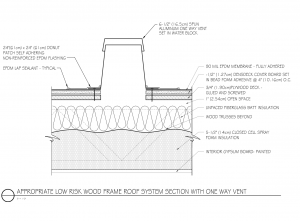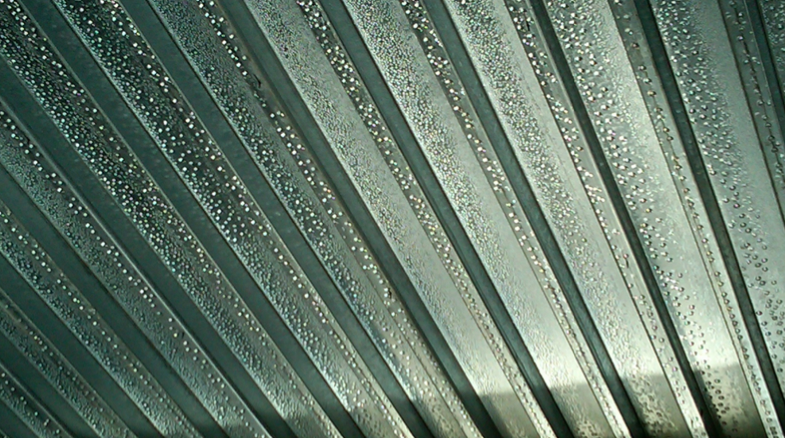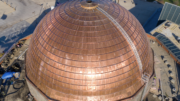ROOF SYSTEM RECOMMENDATIONS
Those designing low-slope residential roofs in northern climates (this encompasses ASHRAE Zone 4 and above) should consider the following design recommendations:
a) Prior to committing to a roof system design, perform a hygrothermal analysis of the proposed systems.
b) Prepare a roof system section from interior ceiling to the roof surface to fully understand the design and its impacts on details, such as the roof edge and access-door sills. Show ceiling penetrations, such
as recessed lights.
c) Consider the use of a robust vapor retarder on the top side of the roof deck and rigid insulation placed above. Detail terminations and penetrations.
d) If choosing to place the insulation below the roof deck, realize the high level of risk and difficulty of successful vapor-retarder installation.
e) Use time-tested ventilation to allow for the release of air vapor that leaks or diffuses into the attic.
f) When allowed by code, use dark-surfaced roofing to promote drying.
g) Fully adhered or ballasted systems should be considered. Mechanically attached systems risk pillowing and drawing internal air upward.

Figure 2: A below-roof-deck remediation solution with closed-cell spray-foam insulation on the gypsum-board ceiling.
Enhancing the built environment is a continuous and laudable goal; doing so without knowledge and respect is a travesty. Ignorance of historical examples will often lead to undesired results. Ventilation of interior spaces has been practiced for centuries in numerous climates and cultures. The “tightening” of buildings has made understanding ventilation that much more important. Low-slope roofs with shallow attics need to be designed with care and detailed by a knowledgeable design professional and not left to the team in the field.




This article leads off with a broadside against reflective roofs that is almost wholly unsupported in the case studies he presents. In both case studies, Hutchinson describes bad design or installation failures, not fundamental materials issues. Both of these examples are relatively new construction that should have been subject to appropriate codes on vapor retardation etc. as required by code.
The fact is, reflective roofing has been in wide use across the country for quite a while. It is the dominant seller in single ply membranes, nationwide. Field tests and WUFI modeling supports what the market is telling us – cool roofs, like other roof types, work well in Chicago and elsewhere when installed properly.
There have been a number of in situ field tests of reflective roofs in the cooler climates Mr. Hutchinson is writing about. What they find consistently is that cool roofs take longer to dry than dark roofs but they dry out over the course of a season. They find that, even under the worst case scenarios (single-ply white membrane over a single layer of insulation with cuts in winter in Climate Zone 5), there is little to no moisture present.
I agree with Mr. Hutchison’s statement that we should promote enhanced built environments with time-tested materials. The benefits and suitability of cool roofs have been shown by science, practice, and the real world for decades. There is plenty of great material for roofing professionals in Mr. Hutchinson’s article, but his bias against reflective roofing is not supported by the case studies he presents here and really misses the mark.